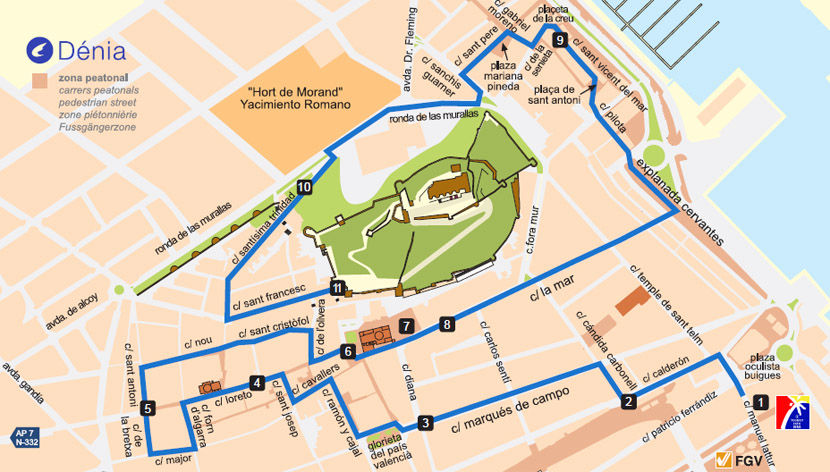
1. Introduction

Welcome to this audioguide of Denia. Denia is located at the north of the province of Alicante, in the Valencian Community. This municipality covers an area of 66 square kilometres and has a population of 44,000 inhabitants. Located at the foot of the Montgó mountain, which was declared a protected natural park, Denia has 20 km of coast. This privileged location provides an enviable warm climate, with an annual average temperature of 20 degrees Celsius.
2. Toy Museum (End of 19th century and 20th century)
First stop of this audioguide, the building that houses the “Museu del Joguet” (Toy Museum) was the ancient “Estació del Nord” train station. It was inaugurated back in 1884. This line linked Denia and Carcaixent. From there it linked to Valencia City or inland Alicante. Today, this building houses a wide collection of toys manufactured in Denia, which proves the importance of this industry from 1904 to the Sixties.
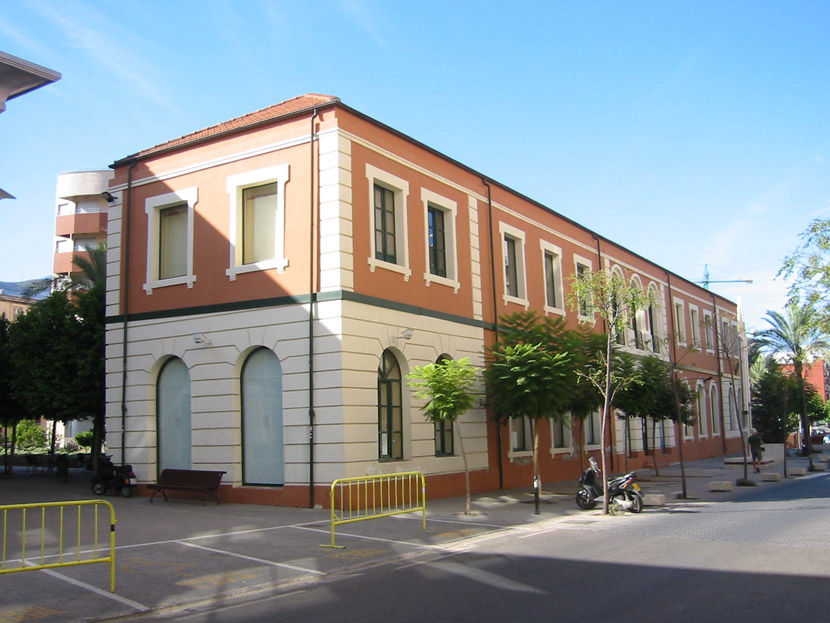
3. Marqués de Campo (street) and Calle Diana (20th century)
During the 20th century, Denia underwent unprecedented economic growth thanks to dry raisin cultivation and commerce, and became a small capital city with a prosperous middle class. Hotels and casinos were built; several maritime shipping companies were established, which linked Denia Port and European, African and American ports, as well as consulates of different countries. The ancient city extended towards the port, and medieval walls were demolished. New streets were created: Marqués de Campo (where we are now with the audioguide) and Calle Diana. Mr. José Campo was an influent Valencian politician, who had family in Denia. He promoted the construction of Carcaixent-Denia railroad and Denia Port works. King Alfonso XII of Spain awarded him the Marqués de Campo title.
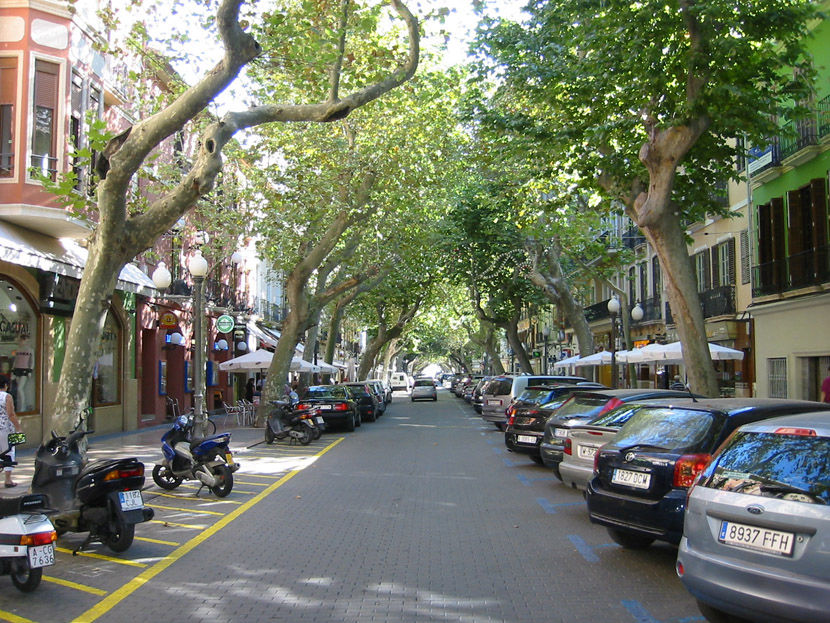
4. Raval de Terra: Cavallers, Loreto, Mayor, Nou, Cop (streets) and Plaza de la Constitución (15th century)
The first settlement of new Christian inhabitants was gathered in the “Raval de Terra”, the only area where there was a continuity of urban use. In 1247, James II, by a royal decree, ordered to demolish all houses and to move the population into the castle walls. This is how Denia village was created. During the 16th century, population increased and made the city grow in the ancient “Raval de Terra”, the place where we are now located with the audioguide and occupied only one part of the area of the ancient Islamic medina. Some of the houses, which were built by families that became rich with the dry raisin commerce during the 19th century, still remain in Cavallers and Loreto streets. They make a great difference to the rest of houses in the urban centre.
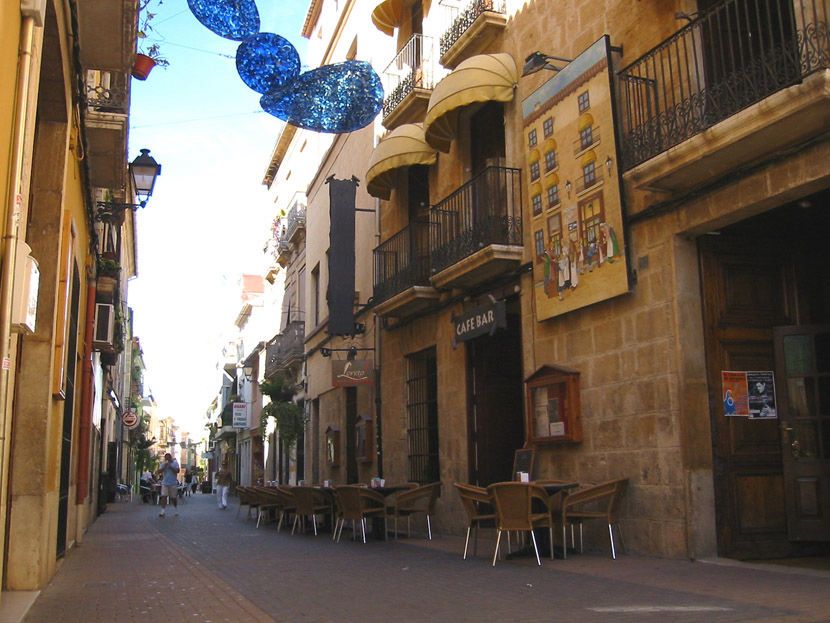
5. War of the Spanish Succession. 20 de junio de 1707
June 20, 1707. We are in the middle of War of the Spanish Succession. King Charles II has died without issue; the Spanish Crown and balance of power in Europe are at stake. This situation involves almost ten European countries. Denia, together with other villages in the Crown of Aragon, supports the House of Austria pretender, Archduke Charles against the absolutist pretender Philip V. Twelve thousand Bourbon soldiers, lead by French General D’Asfeld, attack the city for the second time, which is defended by Diego Rejón de Silva. Four cannons open a breach on the wall, and the assault is rejected by the garrison and voluntary compatriots. The Bourbon troops abandon, and burn crops surrounding the castle in their way out. The street where we are now, Carrer la Bretxa, refers to this fact. After 15 days of siege, Denia surrendered on November 17, 1708. Its population reduced to 114 inhabitants, and the city turned to rubble.
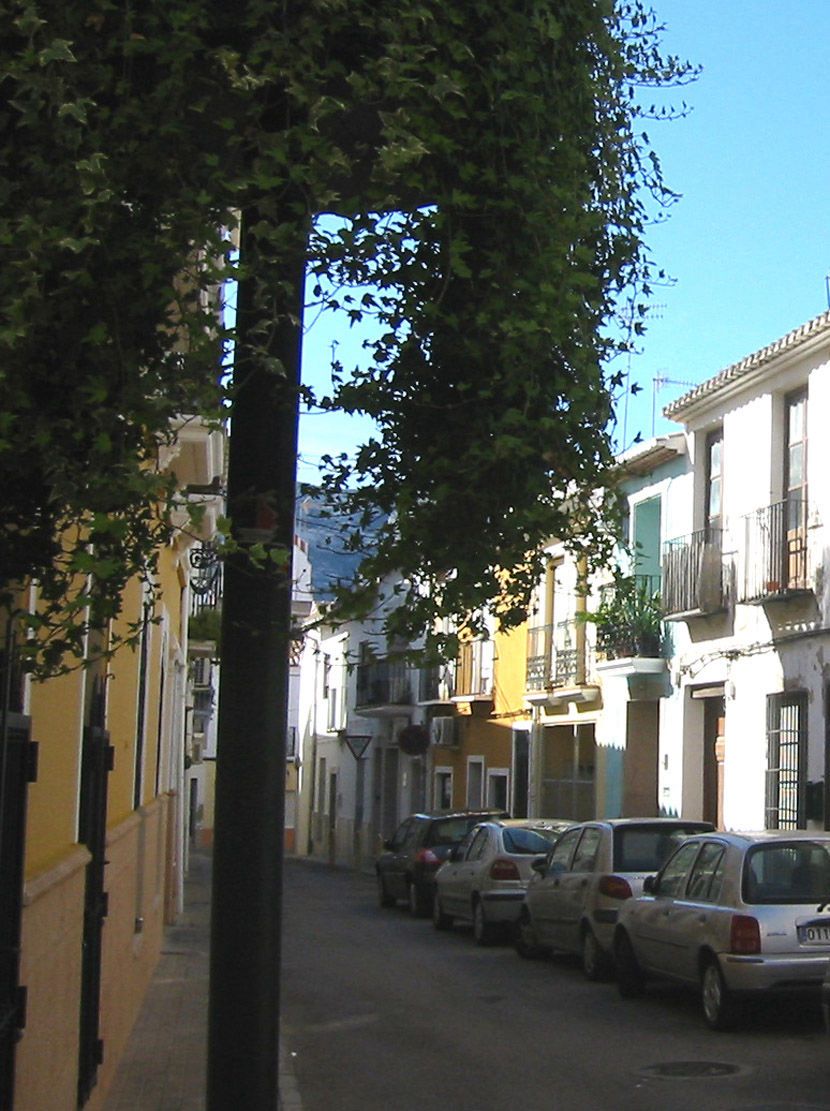
6. Plaza de la Constitución
The audioguide stops now in the ancient Raval de Terra Square. Two buildings stand out:
- The Church: In the place where we can currently find the Iglesia de la Asunción (Assumption Church), a Renaissance hermitage dedicated to Sant Roc was built at the end of the 16th century or the beginning of the 17th century. This hermitage was demolished in order to build the new Sant Roc Chapel in 1649, which was declared in ruins in 1684. The construction of the current church dedicated to Asunción de Nuestra Señora (Assumption of Our Lady) dates from the second third of the 18th century. It was built after demolishing the Baroque-styled Sant Roc Chapel. During the Independence War against Napoleon, at the beginning of the 19th century, and the Spanish Civil War (1936-1939), the church suffered multiple damages, which were subsequently repaired.
- Town Hall: The Town Hall building was built in 1620. It underwent several renovations and additions during the 19th century. In 1877, the neoclassical turret was built.
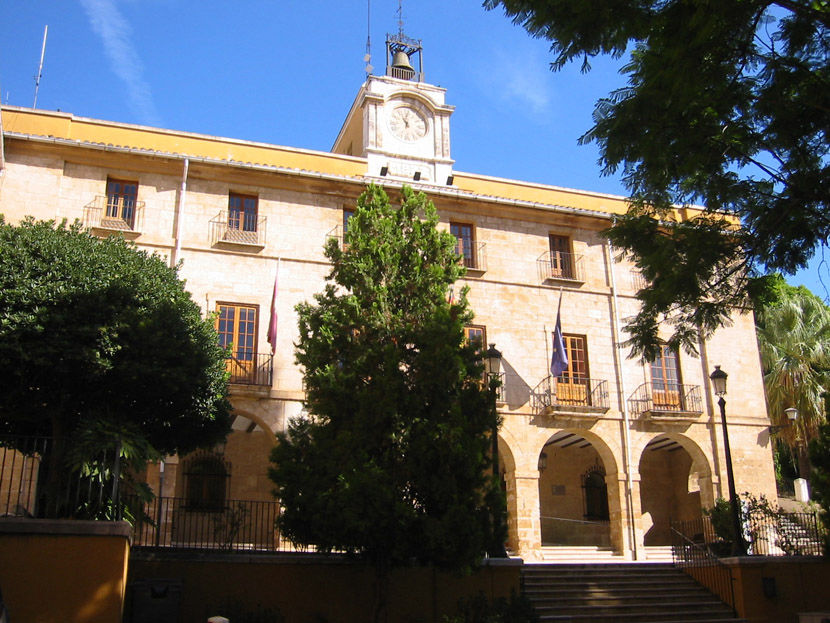
7. Plaza del Consell and tunnel
From this square, we can make two interesting points with the audioguide: If we look towards the castle, we will see the Consell Tower, which gives name to this square. This tower may have been the headquarters of the Municipal Council from the 15th to the 17th century. The sandstone ashlars suffered multiple impacts (still visible) of projectiles fired during the War of the Spanish Succession in 1707. To the right of the Consell Square, we can see a tunnel. We are in the middle of the Spanish Civil War. The urban centre of Denia suffers bomb attacks from the air force and the naval force. The tunnel that protects us and goes through the castle was built at the end of 1937 by Denia's Town Hall so that people could take shelter during the bomb attacks.
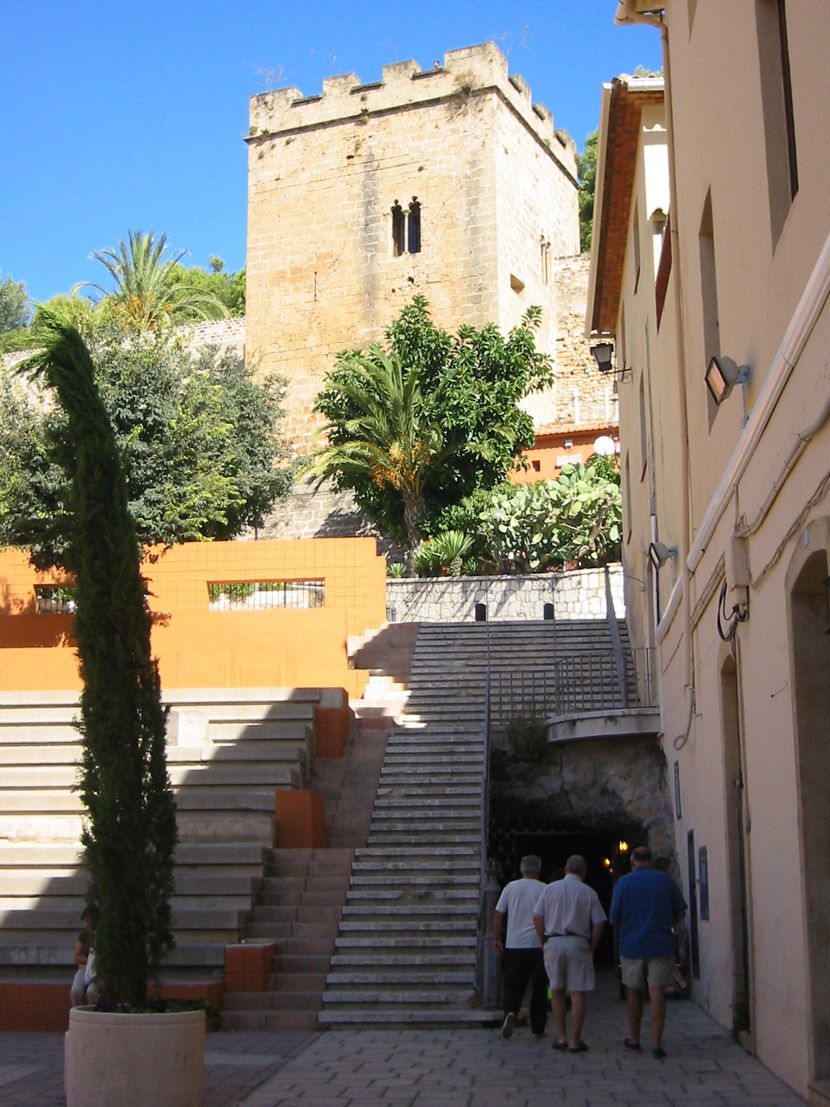
8. Calle la mar
On the upper part of the buildings, we can see with the audioguide the Morand warehouse, dedicated to dry raisin and guano. At the beginning of the 19th century, Denia’s incorporation into the crown that liberated it from the feudal system, as well as a good economic situation thanks to dry raisin commerce, meant a new turn since it enabled the entry of the middle class into the Town Hall. In a short period, Denia became a small capital city with a prosperous middle class.
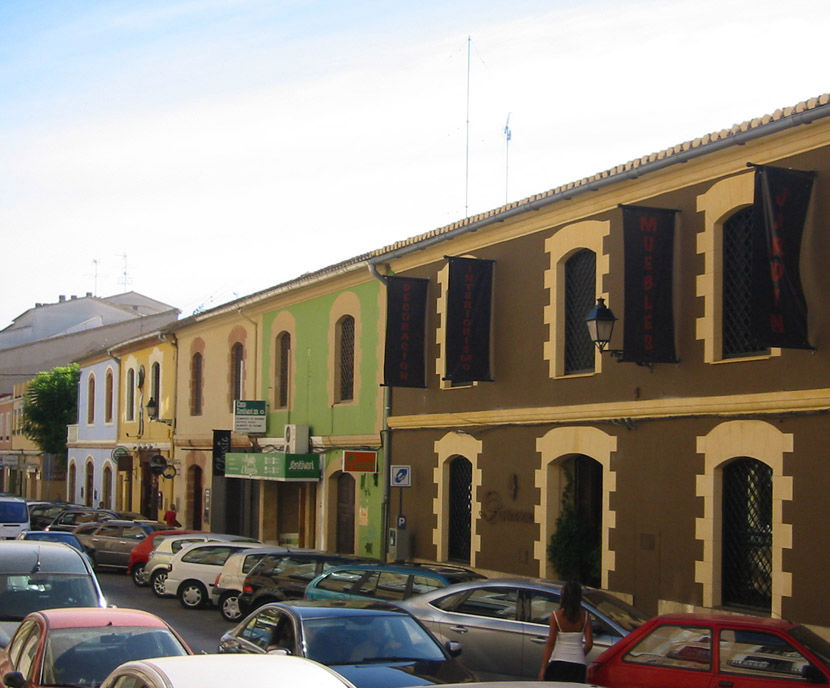
9. Barri Baix la mar
Several events occur in Denia with its port and its neighbourhood as a backdrop. The tradition tells that Miguel de Cervantes disembarked in Denia’s port in 1580, after his captivity in Algiers. In 1599, Lope de Vega, as a journalist, visited Denia. He came with Philip III, who celebrated his engagement with Margarita of Austria. In 1609, over 40,000 Moorish were expelled through Denia’s port. In 1730, there were only seven scattered houses in this neighbourhood. Nevertheless, in 50 years, the wealth generated by the port activities gave rise to a bigger development than that of the city, which was still shut up in its walls. The social and custom differences, which divided both urban centres, caused the independence of this neighbourhood in 1837. The “Poble Nou of Diana” was erected, although they both rejoined two years later. The port relocation in 1917, together with a declining economy, caused its complete stagnation.
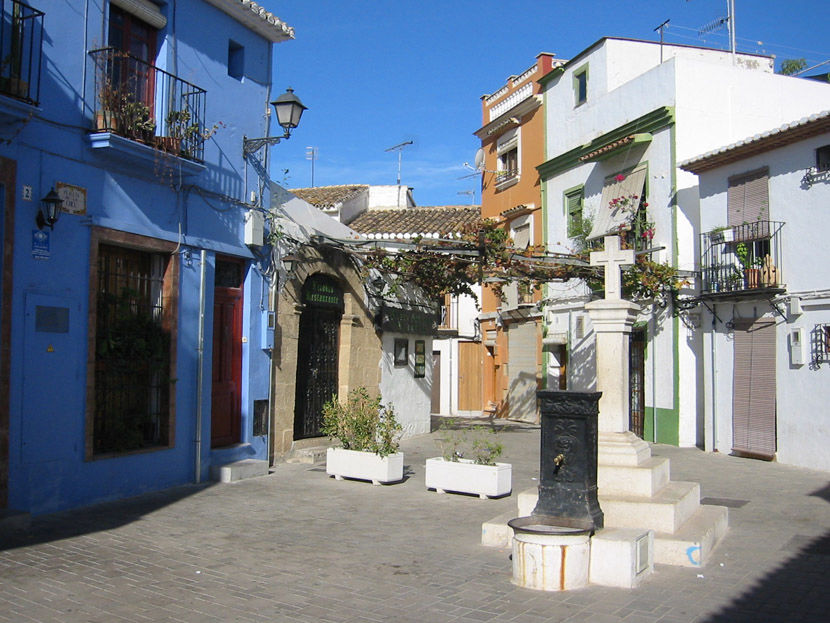
10. Roman Denia: Dianium
Next section of this audioguide, Dianium comes into Roman history with the help of Sertorius, a major figure in Rome’s internal wars during the 1st century BC. He used Denia as a military and naval base in the Mediterranean Sea, and posed a menace to unbeatable Rome. Sertorius was betrayed and defeated in year 73 BC. After this conflict, the Roman-Republican city of Dianium was to be built again. The most splendid moment in Dianium took place between the 1st and 2nd century AC, when big slavery villas, dedicated to wine and oil production for their export to the Gaul, Liguria, Africa and Rome, achieved their maximum potential. Dianium’s decline began back in the 3rd century. The entry of Germanic tribes made the Roman splendour of Dianium to fall into oblivion.
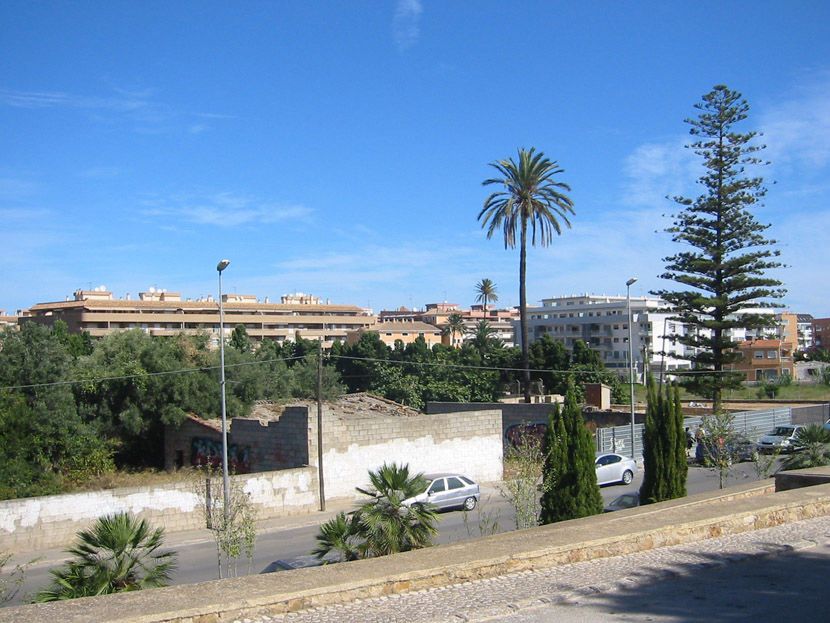
11. Islamic Denia: Daniya
Daniya city was born around its port, where several dockyards for the Caliph’s navy were built in the mid 10th century. In the 11th century, with the division of the Caliphate into several Taifa Kingdoms, the city enjoyed one of its most flourishing periods. Muyahid, a slave officer of the King’s Court, seized the fleet and part of the troops, and established the Daniya Taifa Kingdom, which bordered on Valencia, Murcia, and included the Balearic Islands. He minted his own coins and developed a rich trade in the Mediterranean. He was the patron of philosophers, wise men and doctors. In 1076, this Taifa Kingdom annexed to that of Saragossa. Under the Almoravid Empire, Denia received a great quantity of refugees due to the advance of Christians. In 1172, the Almohade Empire dominated Denia until Pere Eiximen d’en Carròs, captain of King James I, conquered Daniya in 1244.
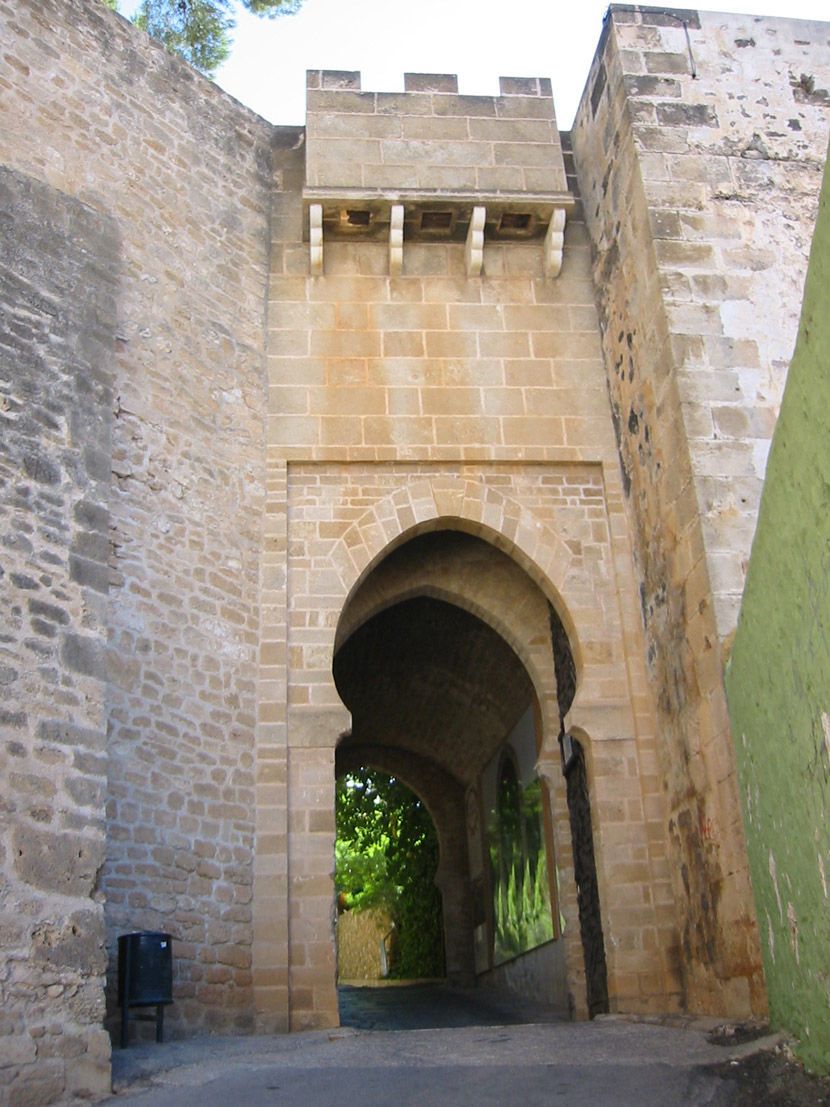
Bluehertz Audio guides has developed for Denia´s town hall an audio guide service available in Spanish, Valencian, English, French and German languages.
Denia´s Tourist Office address: Calle Manuel Lattur, 1- Local E, 03700 Dénia, Alicante.
- Tel.: 966 42 23 67 - www.denia.net -
Back to index